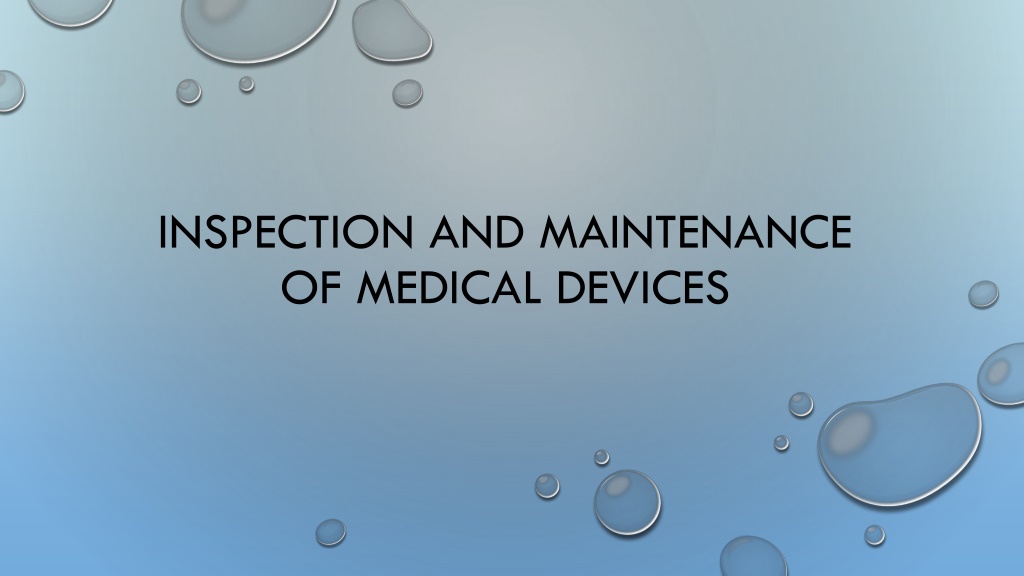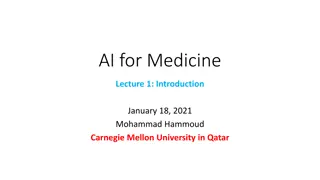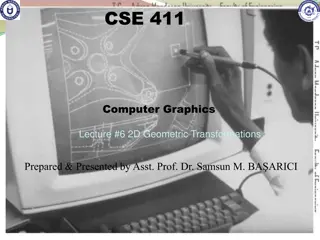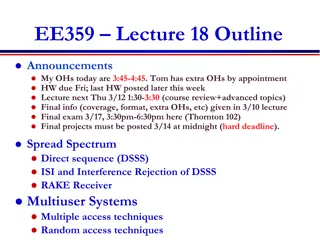
Essential Medical Equipment Management in Healthcare
Explore the importance of inspection, maintenance, and management of essential medical devices in modern healthcare services. Learn about the four main categories of essential medical equipment defined by the World Health Organization (WHO) and the critical role they play in diagnosis, treatment, and patient care. Discover the essential laboratory equipment and general electro-medical equipment used in healthcare settings, as well as the significance of implementing a Medical Equipment Management Program (MEMP) for safe and effective utilization of medical devices in hospitals.
Download Presentation

Please find below an Image/Link to download the presentation.
The content on the website is provided AS IS for your information and personal use only. It may not be sold, licensed, or shared on other websites without obtaining consent from the author. Download presentation by click this link. If you encounter any issues during the download, it is possible that the publisher has removed the file from their server.
E N D
Presentation Transcript
INSPECTION AND MAINTENANCE OF MEDICAL DEVICES
Medical devices are fundamental components of modern health services used for diagnosis, treatment, and monitoring of patients. They are progressively being deployed to increase the capabilities of health diagnostic and treatment services It is required to have practical methods and powerful management strategies to meet the challenges of ever increasing number and use of medical devices
ESSENTIAL MEDICAL EQUIPMENT World health organization (WHO) classifies essential medical equipment in four main categories : 1. Diagnostic imaging equipment is used to take pictures, which help physicians to diagnose a patient s medical. Diagnostic x-ray equipment Ultra-sound equipment ultra-sound equipment may be less frequently used, and is usually added if the budget is available in a hospital.
ESSENTIAL MEDICAL EQUIPMENT 2. Laboratory equipment A variety of laboratory equipment is used for analysis or measurement purposes. * Microscope - blood counter - analytical balance - colorimeter/spectrophotometer - centrifuge - water bath - incubator/oven - refrigerator - distillation and purification apparatus
ESSENTIAL MEDICAL EQUIPMENT 3. General electro-medical equipment portable electrocardiograph external defibrillator portable anesthesia unit Respirator dental chair unit suction pump operating theatre lamp Diathermy unit
ESSENTIAL MEDICAL EQUIPMENT 4. Other support equipment operating theatre table - delivery table - autoclave- for general sterilization. Small sterilizer-for specific services (e.g., Dentistry) electrical generator - electrical power regulator - air conditioner, dehumidifier - refrigerator , small inexpensive equipment and instruments Individual hospital authorities decide which type and what number of these devices are required for their own health service purposes.
MEDICAL EQUIPMENT MANAGEMENT Medical equipment management program (MEMP) is established in hospitals to provide safe and reliable operation of medical equipment and promote its effective utilization . This program defines procedures and policies to manage activities related to medical equipment, from their selection and acquisition to decommission. MEMP ensures that devices can provide reliable and accurate information to clinicians, operate safely for patients, and are used to their fullest capacity.
MEDICAL EQUIPMENT MANAGEMENT The life cycle of medical devices should be thoroughly considered for effective management. Deficiencies in managing each stage of the life cycle, especially in the earlier phases can cause more problems in the succeeding stages. For example, if the maintenance capabilities are considered during acquisition stage, it can hinder the challenges that might be faced during the maintenance stage of the equipment.
LIFE CYCLE OF MEDICAL EQUIPMENT A typical life cycle of medical equipment has the stages shown in the following figure. Proper management of each phase can have a positive impact on the others.
LIFE CYCLE OF MEDICAL EQUIPMENT Planning Acquisition Delivery & Incoming Inspection Inventory & Documentation Installation, Commissioning & Acceptance Training of users & operators Monitoring of use & Performance Maintenance Replacement or Disposal
LIFE CYCLE OF MEDICAL EQUIPMENT Planning In the planning stage, distinct policies on acquisition, utilization and maintenance of medical equipment are clearly outlined. This can significantly minimize the problems arising from the contracts, spare parts and maintenance of the equipment For example, considering the skill level of operators, ensure that only appropriate technology is acquired.
LIFE CYCLE OF MEDICAL EQUIPMENT Acquisition evaluation and procurement are two main aspects of the acquisition phase. Evaluation process includes safety, performance and maintainability assessment of devices. Moreover, the models and manufacturers of equipment are standardized. In the procurement process, it is emphasized that the supplier must supply operating and service manuals, and must provide operation and service training and essential spare parts.
LIFE CYCLE OF MEDICAL EQUIPMENT Delivery and incoming inspection Incoming devices should be checked carefully for possible damages in the shipment process, conformity with the purchase order, and all required accessories, spares, and documents. Inventory and documentation Inventory and documentation are important aspects of equipment management and standardization. Inventory entries should include all accessories, spares, and manuals of each device.
LIFE CYCLE OF MEDICAL EQUIPMENT Installation, commissioning and acceptance In-house technical staff or the suppliers can perform installation and commissioning stage. In the latter, in-house staff should monitor the process and record it in the equipment service history. Training of users and operators Proper training of users and operators assures effectiveness and safety of medical devices, and decreases maintenance errors.
LIFE CYCLE OF MEDICAL EQUIPMENT Monitoring of use and performance In-house technical staff should act as a link between user and supplier and monitor the supplier s technical services. Maintenance Medical equipment must always be maintained in working condition, and calibrated periodically for safety and accuracy , in addition to corrective maintenance, preventive maintenance can be added to enrich the maintenance element of the management plan Replacement and disposal When a medical device is old and its spares run out of supplies, it should be replaced and disposed according to the safety procedures
PREVENTIVE MAINTENANCE OF MEDICAL EQUIPMENT Medical devices are often complex repairable systems consisting of a large number of interacting components, which perform a system s required functions. A repairable system, upon failure, can be restored to satisfactory performance by any method except replacement of the entire. Medical devices usually undergo several types of tests/inspections during their life cycles as described here
PREVENTIVE MAINTENANCE OF MEDICAL EQUIPMENT Acceptance test A series of qualitative and quantitative tasks designed to verify the safety and performance of newly received equipment, as well as conformity to applicable codes, regulations and standards. Operational check Visual and operational check of the equipment s safety and functionality typically performed at the beginning of the day or work period, or just before using equipment on a patient.
PREVENTIVE MAINTENANCE OF MEDICAL EQUIPMENT Safety and performance inspection (SPI) A set of qualitative and quantitative tasks designed to verify the safety and performance of each piece of equipment by detecting potential and hidden failures and taking appropriate actions. After accomplishing the acceptance test for a newly received device, SPIs are scheduled to be performed periodically. If any problem is found at inspection, corrective actions are taken to restore the device or its defective parts to an acceptable level. In addition, a set of failure preventive actions may be taken to prevent future failures and/or restore device function; these include part replacement, calibration, lubrication, etc.
PREVENTIVE MAINTENANCE OF MEDICAL EQUIPMENT Safety and performance inspection (SPI) When a device fails while it is in use, the operator reports the problem, and again appropriate actions (corrective maintenance) are taken. When the repair of a device is no longer technically feasible or cost effective, replacement becomes the best or the only option
COMPUTERIZED MAINTENANCE MANAGEMENT SYSTEMS Computerized maintenance management systems (CMMS) are database applications in an organization that assist in planning and management functions required for effective maintenance. A CMMS to a medical device is similar to an electronic medical record to a patient. It provides the information required for assets management, resource management, financial management, workload, workflow management and regulatory compliance. A CMMS is essential in most healthcare organizations due to the joint commission for the accreditation of healthcare organization requirements under the environment of care standards
COMPUTERIZED MAINTENANCE MANAGEMENT SYSTEMS The core functionalities of a CMMS consist of the modules shown in figure 2.4
CMMS CORE MODULES Inventory control Inventory control is the core module of a CMMS. It allows an operator to track the inventory movement, i.e. Moving in and out of an item from the inventory or from a location to another .To proper planning of service and repair/replacement of each device, healthcare organizations should know the quantity, type, age and the other information related to the device.
CMMS CORE MODULES Work order management system Work order or work request is an electronic document used to schedule routine inspection and maintenance. Work order management system is the heart of the CMMS. Using this module a work order can be created, followed up and completed. It stores all corrective and preventive maintenance requests. It keeps track of the initial customer request, device information, requestor information, date and time of the request, nature of the problem, its urgency, and a summary of the assistance provided so far. All activities performed to a work order should be clearly documented and go into the device s repair and maintenance history.
CMMS CORE MODULES Scheduling/planning This module determines the work required to be performed to satisfy a request. It specifies the most efficient way to perform the work, the schedules and the required resources. Several scheduling procedures are usually considered in the CMMS. It includes periodic or fixed scheduling, floating scheduling, and synchronized scheduling by feature such as device type, location, specialty, and others . periodic scheduling is scheduling of an activity, such as preventive maintenance periodically, regardless the time of the last action. Floating is scheduling of an activity based on the last time the action has been completed for the device, and the conditions of the device. Synchronized scheduling by feature allows to schedule actions according to a technician s expertise, type of the device, department, etc.
CMMS CORE MODULES Vendor management In some hospitals, the most sophisticated equipment such as MRI, scanner, analyzers, etc., Are maintained and services by the original equipment manufacturer (OEM). A good CMMS should integrate the vendor and in-house work to have complete histories of all equipment. Vendor management system should also include the contracts and purchase management subsystems to allow for recording the contracts with the external service providers and purchase transactions made from the vendor.
CMMS CORE MODULES Parts management Most organization uses a just-in-time process for ordering repair parts. Parts usually are divided into three categories: stock parts, contract parts, and noncontracted parts .Stock parts are those, which are purchased and kept in stock by an organization to be used when needed. They are not usually immediately assigned to a specific work order. Contract parts are those included in a prepaid contract. Prepaid contracts are made with external service providers for a certain period. Noncontracted parts are those, which are purchased usually just in time for a specific work order or maintenance action.
CMMS CORE MODULES Preventive maintenance Preventive maintenance is a fundamental module of a CMMS. It generates PM work orders, prioritizes them based on some given criteria, and manipulates them until they are accomplished. Labor Tracking labor resources can be performed using this module. It includes the information of all maintenance personnel and their expertise.
CMMS CORE MODULES Purchasing Purchasing module is to initiate the requisition of parts and materials against a work order and track the delivery and cost data of the item when the part or material arrives. Budgeting Budgeting module is integrated with the planned resources (labor hours, parts and materials) usage on the work orders. It includes the labor, parts and materials rates to calculate or estimate the costs associated with a work order.
SCHEDULED AND NON-SCHEDULED WORK ORDERS The maintenance and inspection data are usually available in the CMMS of a hospital, stored in either scheduled or non-scheduled work orders. Scheduled work orders are used for routine tests (SPIs); however, when a device fails or has a defective part, a non-scheduled work order is requested to fix the problem. Both scheduled and non-scheduled work orders include the basic information of a device and a test checklist designed for a particular class of device. The checklist contains qualitative and quantitative tests; technicians or clinical engineers should use this list to ensure that all necessary tests and checks are accomplished.
SCHEDULED AND NON-SCHEDULED WORK ORDERS Currently, most hospitals merely follow manufacturers recommended intervals for periodic SPI of devices. SPI intervals differ from 6 to 12 months depending on the device type and risk level. Class III (high risk) devices such as defibrillators should be inspected every 6 months, and class II (medium risk) devices like ECGs should be inspected annually. However, the optimality and even the necessity of these recommended intervals are questionable. It is essential to establish an evidence- based inspection or maintenance regimen derived from analysis of field data.











